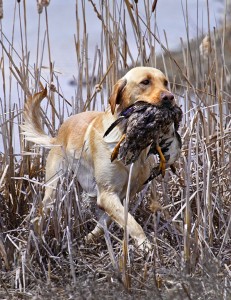August 13, 2012
By James B. Spencer
 Before going into the history of this training procedure, let me first define it: Force-breaking is a structured procedure by which you train your dog to pick up, hold, and carry a bird on the Fetch command and to release it on the Give command.
Before going into the history of this training procedure, let me first define it: Force-breaking is a structured procedure by which you train your dog to pick up, hold, and carry a bird on the Fetch command and to release it on the Give command.
In force-breaking, the trainer uses mild force (usually by squeezing the front paw, pinching the ear, or e-collar stimulation) to teach the dog that proper responses to the two commands are mandatory, not optional. The dog goes through a brief but necessary period of resentment before becoming a true believer. To keep him from associating that resentment with birds, the trainer first goes through the entire process with one or more objects the dog will not link with birds, like wooden dowels, wooden dumbbells, and so forth. Once the dog gets past this resentment and is completely force-broken on those non-bird objects, the trainer repeats the process again with dead birds.
In today's culture, the term "force-breaking" seems to suggest a brutal spirit-breaking process. This misconception causes many neophytes to flinch, frown, and fear the sudden attack by a legion of animal rights looneys. But this term didn't suggest such horrors back in the 19th century, when pointing breed trainers first used it. Back then, many pointing dog trainers also trained horses. But, they didn't train horses; they broke them. Thus, the term came over into the language of pointing dog trainers with no negative connotation. To this day, they call a pointing dog that is steady to wing, shot and kill, a "broke" dog. They call one recently steadied "green-broke."
First: Pointing Breeds
Advertisement
Back in the 1880s, David Sanborn, a professional pointing dog trainer, first developed force-breaking as a way to teach retrieving to dogs with little or no natural retrieving instinct. Many otherwise talented pointing dogs suffer this shortcoming. I once had a pointer who would race out, pick up a shot bird, shake it vigorously to make sure it was dead, drop it, and then take off looking for more birds to point. I cured this problem through force-breaking.
The Sanborn method was, and still is, very gentle, although it takes a while. But the pointing dog trainer has plenty of time for force-breaking, which is a secondary consideration in his training program. His clients will be happy if their dogs show steady improvement in finding and pointing birds. They won't concern themselves about retrieving until their dogs perform solidly in the field. If force-breaking takes three to 12 weeks, so what?
Over the years, these trainers found that force-breaking also sets up a basis for curing certain mouth problems, like hardmouth, sloppy-mouth, and stickiness (refusing to release a bird). I had a shorthair that would eat any bird I shot as quickly as possible right where it fell. That is a severe case of hardmouth. To cure him, I first force-broke him and then followed up with a special procedure to convince him I much preferred he deliver birds to me in no worse condition than that in which he found them. Thereafter, he frequently delivered crippled-but-still-alive quail to me. Different follow-on procedures allow the trainer to cure sloppy-mouth and stickiness. But all three follow-ons have force-breaking as a prerequisite.
Advertisement
Clearly, pointing dog trainers force-break their dogs for two reasons: To overcome a lack of an adequate natural retrieving instinct; and to cure mouth problems.
Then: Retrievers
Retriever trainers scoffed at force-breaking through the 1940s. Why? Because they thought its only purpose was to instill forced retrieving into dogs lacking natural retrieving instincts. Therefore, retrieverites resented any suggestion that retrievers might benefit from it. I have often heard statements like: "My dog retrieves naturally, so why the hell would I bother force-breaking him?" and "Any retriever that has to be force-broken just to get him to retrieve isn't worth wasting training time on! I'd wash out any such worthless beast!"
James Lamb Free, in his 1949 classic book, Training Your Retriever, almost foamed at the mouth at the mere suggestion any worthwhile retriever would ever need force-breaking. But he did acknowledge that a typical retriever, when carrying a bird ashore, often drops it and shakes the water from his coats, after which he may or may not pick it up again. To get reliable delivery to hand, he recommended teaching a retriever to hold, carry, and release on command. Apparently, he did this without realizing he was recommending a good part of the maligned force-breaking process.
However, two factors induced most retriever trainers to adopt the full force-breaking procedure. First, field trials require delivery to hand, which can only be achieved with certainty through force-breaking. Pros who trained retrievers for field trials began to experiment with it, and found it more than useful, because it resulted in reliable delivery to hand and established a solid trainer/dog relationship, which carried over into all forms of control training. Although some pros specialize in training retrievers, most also train pointing breeds, which quite often requires force-breaking. They experimented and found it useful on retrievers, too, so it became more and more widespread.
However, retriever pros face a problem pointing dog pros do not. Every pro, regardless of breed, knows when a new client drops a dog off, he has about a month to make significant and visible progress with the dog. If he doesn't, the client will take his dog home.
During force-breaking, the dog goes through a the customary period of resentment, refusing to retrieve in the field. Ergo, for a retriever, force-breaking must precede serious field retrieving. Thus, retriever pros couldn't use the slow, gentle Sanborn method that takes six to 12 weeks because impatient owners want to see results.
Clearly, to keep himself and his close kin in cider and sowbelly, the retriever pro had to develop a quicker method of force-breaking, ideally one that would take no more than a week. If he could force-break a dog in one week, he would have about three weeks in which to do field work before the client's first visit.
Human ingenuity came to the rescue. Retriever pros developed a force-breaking scheme that took only about one week. But it was as brutal as it was quick. I remember seeing a retriever get out of a pro's truck and crawl on his belly rather than walk. I asked why, and he said, "Oh, he's just out of force-breaking. He'll get over it in a few days."
As the e-collar was refined more and more, trainers developed gentler methods of using it. Thus, force-breaking retrievers has become more socially acceptable while remaining relatively quick. However, it still isn't as gentle as the original Sanborn method used by pointing breed trainers.
 Now: Your Turn
Now: Your Turn
Frankly, force-breaking is as slow and tedious as it is beneficial. So, how should you go about force-breaking young Magic Marker?
First, you could have a pro do it thoroughly in a relatively short time, say, about one to three weeks. Second, if you're a "can-do" person, abounding in perseverance, you could do it yourself, using the slow and gentle Sanborn method. If it takes several weeks, so what? No one will come and take your dog away at the end of the first month. I've usually finished my retrievers in three to six weeks. I once spent three months force-breaking an extremely stubborn Chesapeake. But none of my dogs has ever crawled on their bellies "because he's just coming out of force-breaking."
Jim Spencer's books are available from the WILDFOWL Bookshelf.
